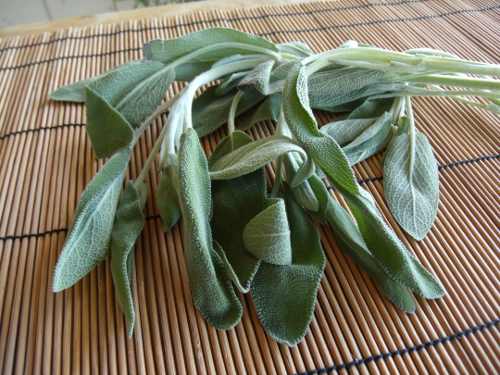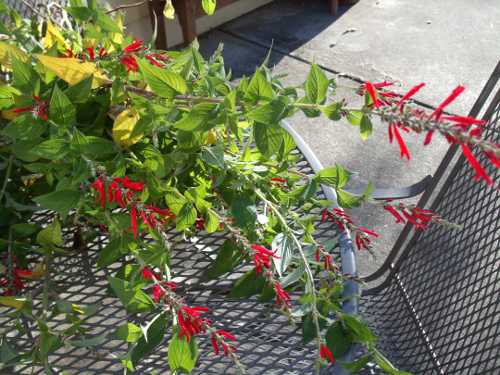
Sage is far more than a flavoring for the stuffing in our Thanksgiving turkeys.
It has a legendary history as a medicinal and culinary herb, and its use in that regard is longer than that of any other herb.
Up until World War II, sage had grown in popularity to become the favorite cooking herb in the United States. At the end of the war, its esteem was quickly supplanted by the oregano brought home from Italy by returning military personnel.
Its once-lost popularity is resurging, it seems, and I’m finding it as a centerpiece ingredient in the repertoire of many a modern-day cook.
While it’s held my respect for many years, I fell in love with it as a culinary herb when I experimented with its use in an intriguing soup recipe, the one that’s offered below. (One caveat must be given in relation to the recipe, however. Sage caramelized until crisp in brown butter is an addictive substance. You’ve been warned.)
Sage is native to the Mediterranean region, though it’s been naturalized in other areas of the world. There are modern sage cultivars that have leaves in shades of purple, rose, cream, or yellow, including in combinations of variegation, but sage’s most common color is gray-green, with a bumpy, almost velvety, texture on the top side of the leaves.
A popular addition to landscapes and gardens, its flowers are typically lavender, but can also be white, pink, or purple. The blooms of pineapple sage are brilliant red, beloved by hummingbirds.
Ancient folklore names sage as an effective remedy for numbers of conditions, including snake bites and infertility. It was believed to ward off evil and was described as having miraculous healing properties in old herbals.
It was one of the ingredients in Four Thieves Vinegar, a medieval blend of herbs that was thought to be a remedy for the plague. In the Middle Ages sage was also employed as a treatment for memory loss, fevers, intestinal and eye problems, liver disease, epilepsy, and infections.
Sage’s Latin name, salvia, is derived from salvare, meaning to save, a reference to the many perceived healing properties of the herb. The ancient Greeks, Romans, and Arabs attributed sage to long life, even immortality.

Sage has a strong, spicy flavor, with hints of musk and camphor, and is best enjoyed cooked, rather than raw. It holds up well to heat and should be added at the beginning of the cooking process, unlike some herbs which quickly lose their flavor. Sage becomes even stronger when dried.
It marries well with beans, particularly white beans, and a bundle of sage tied with cooking string can be thrown into the pot as they cook. Lentils are another good match, as is split pea soup.
Other favorites with sage are some Italian dishes, such as gnocchi and ravioli. It has an affinity for fatty meats, and is often used in the making of sausage. Pork is particularly good with it.
Onions and sage go hand-in-hand, as do some cheeses, particularly mild ones, and all manner of poultry. It’s a major component of poultry seasoning and flavors prepackaged stuffing.
I love finely chopped fresh sage in cornbread; I throw it into the batter before baking. Sage butter is another way to marry the herb with cornbread. It’s delicious spread atop it when warm and fresh from the oven.
Making sage butter is an easy process. Allow butter to soften to room temperature and mix in finely chopped fresh sage, either by hand or in a food processor. Put it in a little tub to store in the fridge, or roll it into a log shape in waxed paper for the freezer. The frozen butter can be cut into medallions for individual servings when needed, such as for bread or melting atop a sage-friendly dish, like chicken breast.
Sage marries well with the beautiful array of winter squashes available now. I especially love roasting butternut squash in the oven with apples and onions and then flavoring it with some crumbled crispy sage, a favorite fall ingredient of mine.
To make crispy sage, heat olive oil until a droplet of water makes it sizzle. Throw in a small handful of fresh sage leaves and cook a few seconds until crispy and darker green. (Don’t let it get brown or its flavor will be diminished.)
Remove the leaves from the oil and onto a paper towel. Repeat the process until the desired amount of sage leaves are crisped. These crispy treats may be crumbled on everything from salads to soups to meats to roasted vegetables, or left whole as an attractive garnish.
The oil used to crisp them may be used to add sage flavor to dishes, as well, such as drizzling atop soup. Since olive oil solidifies after a few days in the fridge, the oil in semi-solid form may be used in much the same way as sage butter.

In addition to the boons offered by its uniquely strong flavor, sage has an array of health benefits.
Modern evidence shows possible uses as an anti-sweating agent, antibiotic, antifungal, astringent and antispasmodic due to the properties of its volatile oils. It has been shown to have potential for producing estrogen and controlling blood sugar.
In a double blind, randomized and placebo-controlled trial, sage was found to be effective in the improvement of memory, even in the management of Alzheimer’s disease.
In other words, much of what the ancients believed about sage has been shown to be true by modern scientific methods.
Today’s recipe makes an especially nice autumn lunch, especially when wind and cold weather abound. Use Lake County pears if you have access to them. Either way, enjoy!
Caramelized pear soup with sage
6 pears
3 tablespoons lemon juice
3 tablespoons unsalted butter
1 tablespoon minced fresh sage leaves
1/2 cup packed light brown sugar
Gray salt
Blue cheese bruschetta (recipe follows)
Preheat broiler.
Peel, halve and core the pears. In a large bowl, toss pears with lemon juice to prevent oxidization.
Melt butter in an ovenproof skillet over medium-low heat and let cook until butter begins to brown.
Add sage to butter and allow it to caramelize.
Add brown sugar and a pinch of salt.
Add pears to mixture, and roll them around to coat thoroughly.
Broil pears in skillet, stirring occasionally, until pears are light brown, about 15 minutes.
Puree pears and brown butter mixture in a blender until smooth. (Esther’s note: You may also use a food processor or immersion blender for a more rustic texture.)
Pour into room temperature soup plates and serve with blue cheese bruschetta.
If preparing ahead of time, refrigerate and reheat slightly before serving.
Blue Cheese Bruschetta
1 loaf walnut bread or raisin bread
4 tablespoons unsalted butter, softened
1/2 cup crumbled blue cheese, crumbled
Preheat broiler.
Slice loaf into finger-wide slices. Cover each slice with butter, then top with blue cheese.
Place bread on baking sheet and broil, with the door open, until the cheese begins to melt, about 30 seconds.
Yields five to eight servings.
Recipe by Michael Chiarello and courtesy of www.FoodNetwork.com.
Esther Oertel, the “Veggie Girl,” is a culinary coach and educator and is passionate about local produce. Oertel gives private cooking lessons. She welcomes your questions and comments; e-mail her at This email address is being protected from spambots. You need JavaScript enabled to view it..
Follow Lake County News on Twitter at http://twitter.com/LakeCoNews, on Tumblr at www.lakeconews.tumblr.com, on Facebook at http://www.facebook.com/pages/Lake-County-News/143156775604?ref=mf and on YouTube at http://www.youtube.com/user/LakeCoNews.

 How to resolve AdBlock issue?
How to resolve AdBlock issue? 





